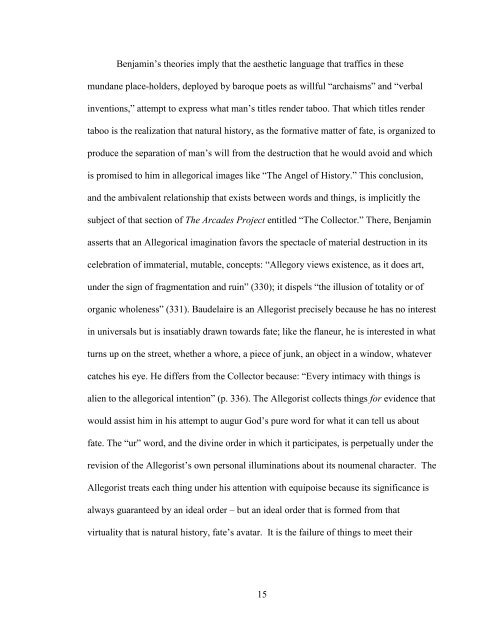TABOO: THE ACTUAL MODERNIST AESTHETIC, MADE REAL A ...
TABOO: THE ACTUAL MODERNIST AESTHETIC, MADE REAL A ...
TABOO: THE ACTUAL MODERNIST AESTHETIC, MADE REAL A ...
You also want an ePaper? Increase the reach of your titles
YUMPU automatically turns print PDFs into web optimized ePapers that Google loves.
Benjamin‟s theories imply that the aesthetic language that traffics in these<br />
mundane place-holders, deployed by baroque poets as willful “archaisms” and “verbal<br />
inventions,” attempt to express what man‟s titles render taboo. That which titles render<br />
taboo is the realization that natural history, as the formative matter of fate, is organized to<br />
produce the separation of man‟s will from the destruction that he would avoid and which<br />
is promised to him in allegorical images like “The Angel of History.” This conclusion,<br />
and the ambivalent relationship that exists between words and things, is implicitly the<br />
subject of that section of The Arcades Project entitled “The Collector.” There, Benjamin<br />
asserts that an Allegorical imagination favors the spectacle of material destruction in its<br />
celebration of immaterial, mutable, concepts: “Allegory views existence, as it does art,<br />
under the sign of fragmentation and ruin” (330); it dispels “the illusion of totality or of<br />
organic wholeness” (331). Baudelaire is an Allegorist precisely because he has no interest<br />
in universals but is insatiably drawn towards fate; like the flaneur, he is interested in what<br />
turns up on the street, whether a whore, a piece of junk, an object in a window, whatever<br />
catches his eye. He differs from the Collector because: “Every intimacy with things is<br />
alien to the allegorical intention” (p. 336). The Allegorist collects things for evidence that<br />
would assist him in his attempt to augur God‟s pure word for what it can tell us about<br />
fate. The “ur” word, and the divine order in which it participates, is perpetually under the<br />
revision of the Allegorist‟s own personal illuminations about its noumenal character. The<br />
Allegorist treats each thing under his attention with equipoise because its significance is<br />
always guaranteed by an ideal order – but an ideal order that is formed from that<br />
virtuality that is natural history, fate‟s avatar. It is the failure of things to meet their<br />
15
















